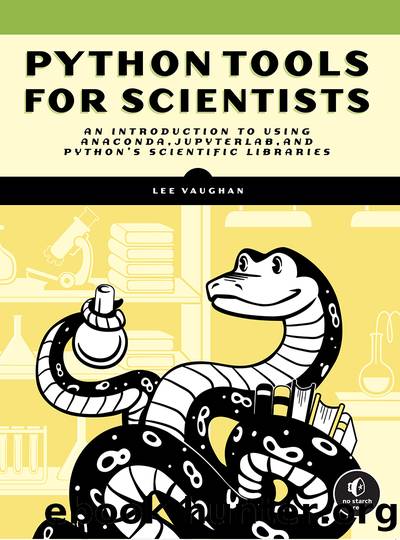Python Tools for Scientists by Lee Vaughan

Author:Lee Vaughan
Language: eng
Format: epub
Publisher: No Starch Press
Published: 2023-04-15T00:00:00+00:00
When to Use OOP
OOP is easier to appreciate when youâre writing large, complex programs because it helps you to structure your code into smaller parts that are easier to understand. It also reduces code duplication and makes code easier to maintain, update, and reuse. As a result, most commercial software is now built using OOP.
Because Python is an object-oriented programming language, youâve already been using objects and methods defined by other people. But unlike languages such as Java, Python doesnât force you to use OOP for your own programs. It provides ways to encapsulate and separate abstraction layers using other approaches such as procedural or functional programming.
Having this choice is important. If you implement OOP in small programs, most of them will feel overengineered. To quote computer scientist Joe Armstrong, âThe problem with object-oriented languages is theyâve got all this implicit environment that they carry around with them. You wanted a banana, but what you got was a gorilla holding the banana and the entire jungle!â
As a scientist or engineer, you can get a lot done without OOP, but that doesnât mean you should ignore it. OOP makes it easy to simulate many objects at a time, such as a flock of birds or a cluster of galaxies. Itâs also important when things that are manipulated, like a GUI button or window, must persist for a long time in the computerâs memory. And because most of the scientific packages youâll encounter are built using OOP, youâll want more than a passing familiarity with the paradigm.
Download
This site does not store any files on its server. We only index and link to content provided by other sites. Please contact the content providers to delete copyright contents if any and email us, we'll remove relevant links or contents immediately.
Practical Guide to Azure Cognitive Services by Chris Seferlis & Christopher Nellis & Andy Roberts(6257)
Unity Artificial Intelligence Programming - Fifth Edition by Dr. Davide Aversa(5849)
Serverless ETL and Analytics with AWS Glue by Vishal Pathak Subramanya Vajiraya Noritaka Sekiyama Tomohiro Tanaka Albert Quiroga Ishan Gaur(4861)
Open Source Projects - Beyond Code by John Mertic(3939)
The AI Product Manager's Handbook by Irene Bratsis(3899)
Graph Data Modeling in Python by Gary Hutson and Matt Jackson(3891)
Cloud Auditing Best Practices by Shinesa Cambric & Michael Ratemo(3536)
Aligning Security Operations with the MITRE ATT&CK Framework by Rebecca Blair(3507)
Graph Data Processing with Cypher by Anthapu Ravindranatha;(1702)
Data Literacy in Practice - A complete guide to data literacy and making smarter decisions with data through intelligent actions (2022) by Packt(1682)
Serverless Machine Learning with Amazon Redshift ML: Create, train, and deploy machine learning models using familiar SQL commands by Debu Panda Phil Bates Bhanu Pittampally Sumeet Joshi(1573)
Network Automation with Go by Nicolas Leiva & Michael Kashin(1528)
Unreal Engine 5 Game Development with C++ Scripting by Zhenyu George Li(1333)
Applied Machine Learning and High-Performance Computing on AWS by Mani Khanuja | Farooq Sabir | Shreyas Subramanian | Trenton Potgieter(1314)
Data Literacy in Practice by Angelika Klidas Kevin Hanegan(1311)
Graph Data Processing with Cypher by Ravindranatha Anthapu(1298)
Implementing Multifactor Authentication: Protect your applications from cyberattacks with the help of MFA by Marco Fanti(1192)
Fuzzing Against the Machine: Automate vulnerability research with emulated IoT devices on QEMU by Antonio Nappa Eduardo Blazquez(1170)
The AI Product Manager's Handbook: Develop a product that takes advantage of machine learning to solve AI problems by Irene Bratsis(1024)
